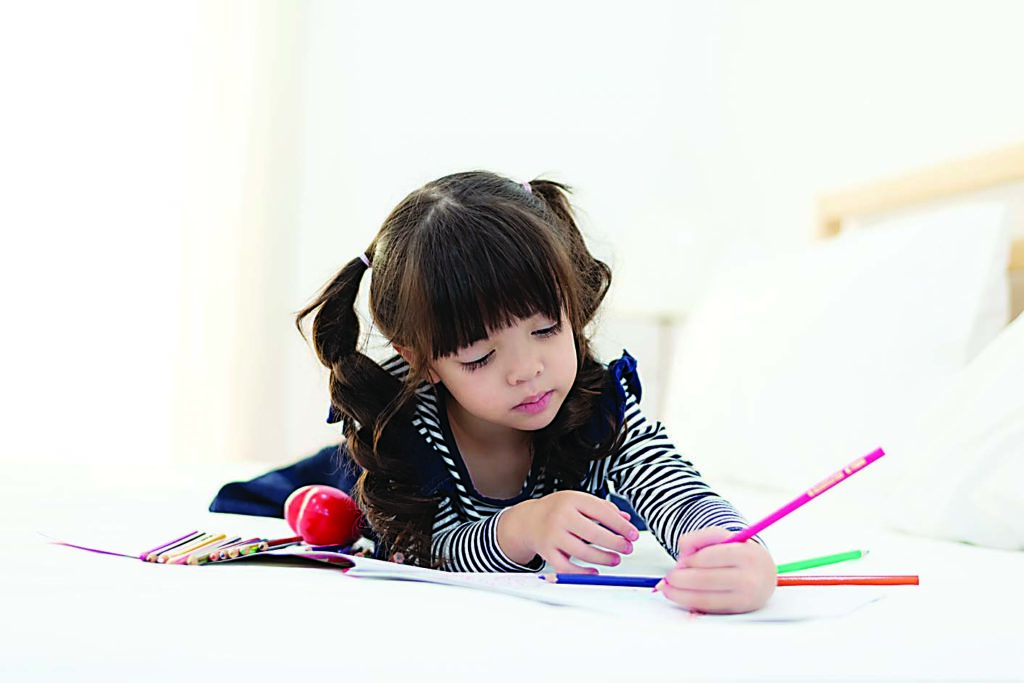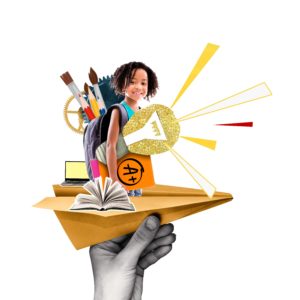
Your friend puts you in charge of party decorations because she claims she’s “not artistic.” When we categorize ourselves as creative or not creative—left-brained or right-brained—we simplify the processes in the brain that are really quite complex and often not isolated to one area of the brain.
Despite what we high school algebra-phobes would like to believe, many opportunities exist where art can seamlessly work its way into math curricula, for example. Plus, research proves the benefit of arts integration through a child’s ability to retain new information for longer periods.
A Passion for Arts Integration
Integrating arts into education is a career-long passion for Mariale Hardiman, professor, co-founder and director of the Johns Hopkins Neuro-Education Initiative (NEI), designed to bring educators knowledge from the science of learning to inform teaching and learning. Part of this initiative included the creation of the Mind, Brain and Teaching (MBT) certificate and doctoral specialization at Johns Hopkins University (JHU) School of Education.
Before joining JHU in 2006, Hardiman worked in the Baltimore City Public Schools for more than 30 years, serving in various leadership and administration-related roles. As the principal of Roland Park Elementary and Middle School, she led the school to its designation as a Blue Ribbon School of Excellence and recognition for innovative arts programming.
“During the time of high-stakes testing, our school focus was to meet and exceed state targets for proficiency in reading and math,” Hardiman says. “Our faculty became laser-focused on achieving those goals. But I felt that something was missing. The joy of learning seemed to dissipate the more we focused on raising and maintaining standardized test scores. Adding arts programming and integrating the arts into our content instruction seemed to be the antidote to the kind of regimented teaching that we were required to be engaged in by the school district.”
Hardiman reports that once art integration began, administrators could see students learning via visual and performing arts. Plus, teachers reported that students appeared to learn and retain information better when the arts were infused into instruction.
Similarly, Alexandra Murtaugh, now a research and development coordinator for the education nonprofit NeuroLogic by Lakeside, spent nine years as a high school biology teacher in the Philadelphia area.
“My interest in arts education actually came because I saw students interact with the material differently when it was project-based. I had the opportunity to collaborate with someone from our local mural arts program, who helped design relevant science and art projects that propelled my students’ learning,” Murtaugh says.
Murtaugh has found arts integration particularly helpful for students with backgrounds of trauma because it gives them an opportunity to create an emotional release—it allows for a voice in the classroom, along with being naturally meditative.
The Educator’s Challenge
Hardiman believes that students who have the most to gain from an arts-integrated education are often the least likely to have access to them, such as students who attend under-resourced schools, those with learning differences and bilingual English language learners. She cautions that arts integration does not replace general arts education.

“Arts educators who are schooled in arts standards and know how to implement arts curriculum are essential in schools (including vocal and instrumental music, visual arts and theater teachers and dance educators),” Hardiman says. “Some districts have terminated arts educators because they believe that arts integration will be all students need.”
The prevalence of arts integration in the classroom has grown over the past several years, which Hardiman attributes to greater awareness of the research, popular media and arts-based organizations providing training and funding.
Many schools embracing arts integration are private or charter schools, or those with a STEAM (science, technology, engineering, arts and mathematics) focus.
Even with research to back its positive effects, several challenges stand in the way
of integration.
• Schools prioritize high-stakes testing, which focuses resources on teaching to the tests.
• Arts integration requires skilled teacher training and instruction.
• Teachers must focus on reaching benchmarks and fear taking time away from the required curriculum. Murtaugh says that resources were always a challenge to integrating arts into her classroom and she typically paid for art supplies out of her own pocket.
Yet another challenge, according to Tricia Beck, director of teaching and learning for the Great Valley School District in southeastern Pennsylvania, is the lack of collaboration among departments.
Plus, innovators are working against traditional models of measuring academic success such as “rigor,” “assessment” and “compliance” rather than “engagement” and “sustained learning,” she notes.
Small Steps Toward Achieving Arts Integration
Beck—whose background includes serving as the adjunct professor at JHU and working as an interventionalist for special populations within her school district—believes arts integration can, and should, start small.
While Beck’s school system began a STEAM initiative five years ago, the COVID pandemic slowed its projection. Much of the arts integration she sees at the elementary school level happens organically through project-based learning.
One example of successful arts integration happening at the high school level is within special student populations. The teachers of these students look for ways to create project-based learning and life skills throughout their curriculum.
Recently, the students worked in family and consumer science classes to develop a recipe for dog biscuits. Collaborating with the art department, the students designed logos and marketing collateral and eventually developed a business plan to sell the product.
“It was a true life experience that integrated the arts and made it more meaningful for students,” Beck says.
Hardiman agrees that educators can implement activities using visual and performing arts without a total curriculum overhaul. For example, when reading narrative literature, students can show how a character in a story might feel by taking a body pose, known as tableau, to depict the understanding of a character’s role in the story. Similarly, the same exercise could be used to demonstrate cell structures in a biology class.
“Many teachers use tableau and a variety of techniques such as role playing, improvisation, visual note taking, storyboarding, skits and more to add interest and depth to the curriculum,” Hardiman says. “Researchers and practitioners show how this type of instruction can engage students more than traditional instruction that relies heavily on verbal and written work.”
Murtaugh recommends integrating an art activity into the first five minutes of a class as a reset for students as they transition from another subject.
Parents can integrate art into learning at home, such as incorporating drawings or cartoons into a homework unit or working on memory skills via repeated songs.
“Most people are artistic and creative in some way. If we communicate this to our kids, we can support them in figuring out how they express their own creativity,” Murtaugh says.
Beck hopes to see greater opportunities in K-12 education for department collaboration by challenging the current way schools are structured. This action requires administrators to support teachers working together and cultivating professional development while balancing other demands of instruction.
Looking at the positive effects of arts integration, Beck sees “true engagement, not just compliance,” she says. Arts integration permits a deeper understanding of the academic content, which ultimately leads to deeper or sustained learning.
Learn more about the design of arts-integrated learning units that can be used in preschool, higher education or professional training programs with The Brain-Targeted Teaching Model. Visit braintargetedteaching.org







